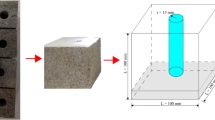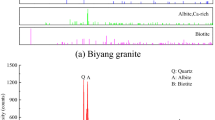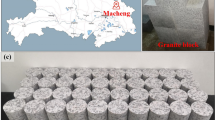Abstract
Reservoir rocks have an obvious initial nonlinear crack-closure stage during geothermal energy exploration using enhanced geothermal systems (EGSs). Therefore, the purpose of this research is to establish a quantitative model considering the influence of initial nonlinear characteristics on geothermal reservoirs. According to effective medium theory (EMT), deformation of reservoir rocks after thermal shocks can be divided into rock frame and void sections, and the effect of microcracks is considered in the establishment of the proposed model. Compressive tests conducted on Suizhou granite specimens after cyclic water cooling were used to validate this model. Furthermore, the influence of microcracks on initial crack closure part of Suizhou granite specimens after thermal shocks was revealed by scanning electron microscope (SEM) observation. There is a negative exponential relationship between the axial stress–strain in void section of specimens after cyclic water cooling. The crack closure stage in the stress–strain relation of Suizhou granite after thermal shocks is more apparent with heating temperature and cyclic time. The proposed model well characterizes the crack closure part in the stress–strain curves of specimens after cyclic water cooling. The proposed model describes the initial nonlinear stage of surrounding geothermal reservoir granite and provides theoretical support for the evaluation of stability in EGS engineering design.













Similar content being viewed by others
Data Availability
Data will be made available on request.
Abbreviations
- C ijkl :
-
Effective compliance tensor of rock after thermal shocks
- C ijkl 0 :
-
Skeleton section compliance tensor
- ΔC ijkl :
-
Extra void section compliance tensor
- \({\delta }_{0}={h}_{0}^{v}/{h}_{0}\) :
-
Maximum strain of the crack closure stage
- ε I (i = 1, 2 or 3):
-
Macroscopic principal strain of the representative column element (RCE)
- ε sc :
-
Peak strain
- \({\varepsilon }_{i}^{s}\) :
-
Microscopic strain of skeleton section
- \({\varepsilon }_{i}^{v}\) :
-
Microscopic strain of void section
- \({\varepsilon }_{i}^{vm}\) :
-
Transient strain of void section
- ε ij :
-
Total strain of rock
- \({\varepsilon }_{ij}^{0}\) :
-
Skeleton section
- Δε ij :
-
Extra strain of void section
- E T :
-
Elastic modulus of skeleton section
- \({E}_{T}^{s}\) :
-
Elastic modulus of void section
- \(\Delta {\sigma }_{i}^{m}\) (s = 1, 2, …, n):
-
m Multi-level stress increments
- \({E}_{T}^{vm}\) :
-
Elastic modulus of void section being applied stress increment of Δσim.
- h 0 :
-
Initial full height of RCE
- Δh :
-
Macroscopic deformation of RCE
- \({h}_{0}^{s}\) :
-
Heights of skeleton section
- Δh s :
-
Macroscopic deformation induced by the skeleton section
- h 0 v :
-
Heights of the void section
- Δh v :
-
Macroscopic deformation induced by void section
- Δh v m :
-
Microscopic deformation caused by s level stress increment Δσim
- ρ f :
-
Microcrack density
- R2 :
-
The correlation coefficient
- σ cc :
-
Crack closure stress
- σ ci :
-
Crack initiation stress
- σ cd :
-
Crack damage stress
- σ kl :
-
Applied stress
- σ I (i = 1, 2 or 3):
-
Direction of principal stress
- n :
-
Total number of multi-level stress increment
- T :
-
Heating temperature
- UCST :
-
Uniaxial compression stress
- \({v}_{T}\) :
-
Poisson’s ratio of the skeleton section
- \({v}_{T}^{v}\) :
-
Poisson’s ratio of void section
- \({v}_{T}^{vm}\) :
-
Poisson’s ratio of void section being applied stress increment of Δσim
References
Aliyu MD, Archer RA (2021) Numerical simulation of multifracture HDR geothermal reservoirs. Renew Energy 164:541–555
Bai Y, Shan RL, Ju Y, Wu YX, Sun PF, Wang ZE (2020) Study on the mechanical properties and damage constitutive model of frozen weakly cemented red sandstone. Cold Reg Sci Technol 171:102980
Breede K, Dzebisashvili K, Liu XL, Falcone G (2013) A systematic review of enhanced (or engineered) geothermal systems: past, present and future. Geotherm Energy 1:4
Cai M, Kaiser PK, Tasaka Y, Maejima T, Morioka H, Minami M (2004) Generalized crack initiation and crack damage stress thresholds of brittle rock masses near underground excavations. Int J Rock Mech Min Sci 41(5):833–847
Cao W, Tan X, Zhang C, He M (2019) Constitutive model to simulate full deformation and failure process for rocks considering initial compression and residual strength behaviors. Can Geotech J 56(5):649–661
Chang SH, Lee CI (2004) Estimation of cracking and damage mechanisms in rock under triaxial compression by moment tensor analysis of acoustic emission. Int J Rock Mech Min Sci 41(7):1069–1086
Chen Y, Ma GW, Wang HD, Li T (2018a) Evaluation of geothermal development in fractured hot dry rock based on three dimensional unified pipe-network method. Appl Therm Eng 136:219–228
Chen Y, Ma GW, Wang HD (2018b) Heat extraction mechanism in a geothermal reservoir with rough-walled fracture networks. Int J Heat Mass Transf 126:1083–1093
Dwivedi RD, Goel RK, Prasad V, Sinha A (2008) Thermo-mechanical properties of Indian and other granites. Int J Rock Mech Min Sci 45(3):303–315
Eberhardt E, Stead D, Stimpson B, Read RS (1998) Identifying crack initiation and propagation thresholds in brittle rock. Can Geotech J 35(2):222–233
Fan LF, Gao JW, Wu ZJ, Wu ZJ, Yang SQ, Ma GW (2018) An investigation of thermal effects on micro-properties of granite by X-ray CT technique. Appl Therm Eng 140:505–519
Feng WL, Qiao CS, Wang T, Yu MY, Niu SJ, Jia ZQ (2020) Strain-softening composite damage model of rock under thermal environment. Bull Eng Geol Environ 79(11):4321–4333
Geraud Y (1994) Variations of connected porosity and inferred permeability in a thermally cracked granite. Geophys Res Lett 21(11):979–982
Gong FC, Guo TK, Sun W, Li ZM, Yang B, Chen YM, Qu ZQ (2020) Evaluation of geothermal energy extraction in Enhanced Geothermal System (EGS) with multiple fracturing horizontal wells (MFHW). Renew Energy 151:1339–1351
Griffiths L, Lengliné O, Heap MJ, Baud P, Schmittbuhl S (2018) Thermal cracking in westerly granite monitored using direct wave velocity, coda wave interferometry, and acoustic emissions. J Geophys Res: Solid Earth 123:2246–2261
Isaka BLA, Ranjith PG, Rathnaweera TD, Perera MSA, Kumari WGP (2019) Influence of long-term operation of supercritical carbon dioxide based enhanced geothermal system on mineralogical and microstructurally-induced mechanical alteration of surrounding rock mass. Renew Energy 136:428–441
Ji PQ, Zhang XP, Zhang Q (2018) A new method to model the non-linear crack closure behavior of rocks under uniaxial compression. Int J Rock Mech Min Sci 112:171–183
Jin PH, Hu YQ, Shao JX, Zhao GK, Zhu XZ, Li C (2019) Influence of different thermal cycling treatments on the physical, mechanical and transport properties of granite. Geothermics 78:118–128
Kang FC, Jia TR, Li YC, Deng JH, Tang CA, Huang X (2021) Experimental study on the physical and mechanical variations of hot granite under different cooling treatments. Renew Energy 179:1316–1328
Kelkar S, Woldegabriel G, Rehfeldt K (2016) Lessons learned from the pioneering hot dry rock project at Fenton Hill, USA. Geothermics 63:5–14
Kim K, Kemeny J, Nickerson M (2014) Effect of rapid thermal cooling on mechanical rock properties. Rock Mech Rock Eng 47:2005–2019
Kumari WGP, Beaumont DM, Ranjith PG, Perera MSA, Isaka BLA, Khandelwal M (2019) An experimental study on tensile characteristics of granite rocks exposed to different high-temperature treatments. Geomech Geophys Geo Energy Geo Resour 5:47–64
Li Q, Li XB, Yin TB (2021) Factors affecting pore structure of granite under cyclic heating and cooling: a nuclear magnetic resonance investigation. Geothermics 96(4):102198
Lim SS, Martin CD, Akesson U (2012) In-situ stress and microcracking in granite cores with depth. Eng Geol 147–148:1–13
Liu HH, Rutqvist J, Berryman JG (2009) On the relationship between stress and elastic strain for porous and fractured rock. Int J Rock Mech Min Sci 46(2):289–296
Liu XB, Zhang ZY, Ge ZL, Zhong CL, Liu L (2021) Brittleness evaluation of saturated coal based on energy method from stress-strain curves of uniaxial compression. Rock Mech Rock Eng 54:3193–3207
Lockner DA, Byerlee JD, Kuksenko V, Ponomarev A, Sidorin A (1991) Quasi-static fault growth and shear fracture energy in granite. Nature 359:39–42
Mahmutoglu Y (1998) Mechanical behaviour of cyclically heated fine grained rock. Rock Mech Rock Eng 31(3):169–179
Martin CD, Chandler NA (1994) The progressive fracture of Lac du Bonnet granite. Int J Rock Mech Min Sci Geomech Abstr 31(6):643–659
Mccartney JS, Sánchez M, Tomac I (2016) Energy geotechnics: advances in subsurface energy recovery, storage, exchange, and waste management. Comput Geotech 75:244–256
Nasseri M, Schubnel A, Young RP (2007) Coupled evolutions of fracture toughness and elastic wave velocities at high crack density in thermally treated Westerly granite. Int J Rock Mech Min Sci 44(4):601–616
Nasseri M, Schubnel A, Benson PM, Young RP (2009) Common evolution of mechanical and transport properties in thermally cracked westerly granite at elevated hydrostatic pressure. Pure Appl Geophys 166:927–948
Nicksiar M, Martin CD (2012) Evaluation of methods for determining crack initiation in compression tests on low-porosity rocks. Rock Mech Rock Eng 45(4):607–617
Ning P, Ju F, Su HJ, He ZQ, Xiao M, Zhang YZ, Zhou C, Wang D (2021) An investigation on the deterioration of physical and mechanical properties of granite after cyclic thermal shock. Geothermics 97:102252
Olasolo P, Juárez MC, Morales MP, D’Amico S, Liarte IA (2016) Enhanced geothermal systems (EGS): a review. Renew Sustain Energy Rev 56:133–144
Peng J, Rong G, Cai M, Zhou CB (2015) A model for characterizing crack closure effect of rocks. Eng Geol 189:48–57
Rong G, Peng J, Cai M, Yao MD, Zhou CB, Song S (2018) Experimental investigation of thermal cycling effect on physical and mechanical properties of bedrocks in geothermal fields. Appl Therm Eng 141:174–185
Rong G, Sha S, Li BW, Chen ZH, Zhang ZY (2021) Experimental investigation on physical and mechanical properties of granite subjected to cyclic heating and liquid nitrogen cooling. Rock Mech Rock Eng 54:2383–2403
Siratovich PA, Villeneuve MC, Cole JW, Kennedy BM, Bégué F (2015) Saturated heating and quenching of three crustal rocks and implications for thermal stimulation of permeability in geothermal reservoirs. Int J Rock Mech Min Sci 80:265–280
Somerton WH (1992) Thermal properties and temperature-related behavior of rock/fluid systems. Elsevier, Amsterdam, pp 22–29
Spichak V, Zakharova O (2022) Permeability estimating beyond boreholes from electrical conductivity data determined from magnetotelluric sounding: Soultz-sous-Forêts site (France) case study. Geothermics 105:102513
Tapponnier P, Brace WF (1976) Development of stress-induced microcracks in Westerly Granite. Int J Rock Mech Min Sci Geomech Abstr 13(4):103–112
Tian H, Mei G, Jiang GS, Qin Y (2017) High-temperature influence on mechanical properties of diorite. Rock Mech Rock Eng 50(6):1661–1666
Ulusay R, Hudson J (2007) The complete ISRM suggested methods for rock characterization, testing and monitoring: 1974–2006, 2006th edn. Elsevier, Antalya
Walsh JB (1965) The effect of cracks on the compressibility of rock. J Geophys Res 70(2):381–389
Wang F, Frühwirt T, Li Y (2020) The influence of temperature and high-speed heating on tensile strength of granite and the application of digital image correlation on tensile failure processes. Rock Mech Rock Eng 53(4):1935–1952
Wu QH, Weng L, Zhao YL, Guo BH, Luo T (2019) On the tensile mechanical characteristics of fine-grained granite after heating/cooling treatments with different cooling rates. Eng Geol 253:94–110
Xiao H, Bruhns OT, Meyers A (2006) Elastoplasticity beyond small deformations. Acta Mech 182:31–111
Xu XL, Karakus M (2018) A coupled thermo-mechanical damage model for granite. Int J Rock Mech Min Sci 103:195–204
Yanagisawa N, Matsunaga I, Sugita H, Sato M, Okabe T (2008) Temperature-dependent scale precipitation in the Hijiori Hot Dry Rock system. Jpn Geotherm 37(1):1–18
Yang SQ, Ranjith PG, Jin HW, Tian WL, Ju Y (2017) An experimental investigation on thermal damage and failure mechanical behavior of granite after exposure to different high temperature treatments. Geothermics 65:180–197
Zhang Y, Feng XT, Yang C, Zhang XW, Sharifzadeh M, Wang ZF (2019) Fracturing evolution analysis of Beishan granite under true triaxial compression based on acoustic emission and strain energy. Int J Rock Mech Min Sci 117:150–161
Zhang GK, Li HB, Wang MY, Li XF (2020) Crack initiation of granite under uniaxial compression tests: a comparison study. J Rock Mech Geotech Eng 12(3):656–666
Zhang Y, Feng XT, Yang CX, Han Q, Wang ZF, Kong R (2021) Evaluation method of rock brittleness under true triaxial stress states based on pre-peak deformation characteristic and post-peak energy evolution. Rock Mech Rock Eng 54:1277–1291
Zhao K, Yu X, Zhou Y, Wang Q, Wang JQ, Hao JL (2020) Energy evolution of brittle granite under different loading rates. Int J Rock Mech Min Sci 132(7):104392
Zhou HQ, Wang ZH, Ren WG, Liu ZL, Liu JF (2019) Acoustic emission based mechanical behaviors of Beishan granite under conventional triaxial compression and hydro-mechanical coupling tests. Int J Rock Mech Min Sci 123:104125
Zhu D, Jing HW, Yin Q, Ding SX, Zhang JH (2020) Mechanical characteristics of granite after heating and water-cooling cycles. Rock Mech Rock Eng 53(4):2015–2025
Zhu ZN, Tian H, Wang R, Jiang GS, Dou B, Mei G (2021) Statistical thermal damage constitutive model of rocks based on Weibull distribution. Arab J Geosci 14:495
Acknowledgements
This work is jointly supported by the National Natural Science Foundation of China (No. 42207178, 42077231), the China Postdoctoral Science Foundation Funded Project (No. 2022M713373), the Open Research Fund Program of Key Laboratory of Deep Geothermal Resources, Ministry of Natural Resources (No. KLDGR2022G03), the Open Research Fund of Engineering Research Center of Rock-Soil Drilling & Excavation and Protection, Ministry of Education (No. 202313) and Open Research Fund of Engineering Research Center of Geothermal Resources Development Technology and Equipment, Ministry of Education (No. 23004). We are grateful to the 3Gdeep group (Department of Civil Engineering, Monash University, Australia) for their help in providing valuable suggestions on English polishing.
Author information
Authors and Affiliations
Corresponding author
Ethics declarations
Conflict of interest
The authors declare that they have no conflicts of interest in this work. All data, models, or codes supporting the findings of this study are available from the corresponding author on request.
Rights and permissions
About this article
Cite this article
Zhu, Z., Yang, S., Ranjith, P.G. et al. A model for characterization of crack closure stage in stress–strain curves of Suizhou granite after exposure to various thermal shocks. Bull Eng Geol Environ 83, 231 (2024). https://doi.org/10.1007/s10064-024-03685-y
Received:
Accepted:
Published:
DOI: https://doi.org/10.1007/s10064-024-03685-y




